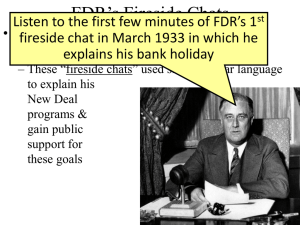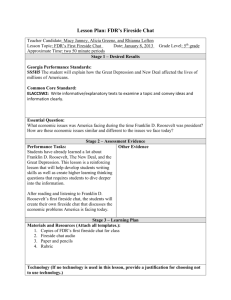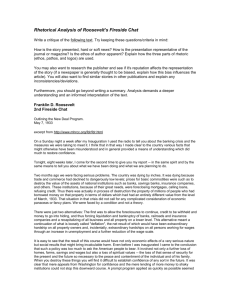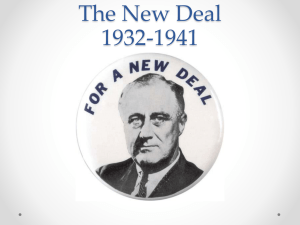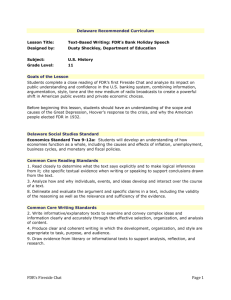Lesson Plan Format - Social Studies Home
advertisement
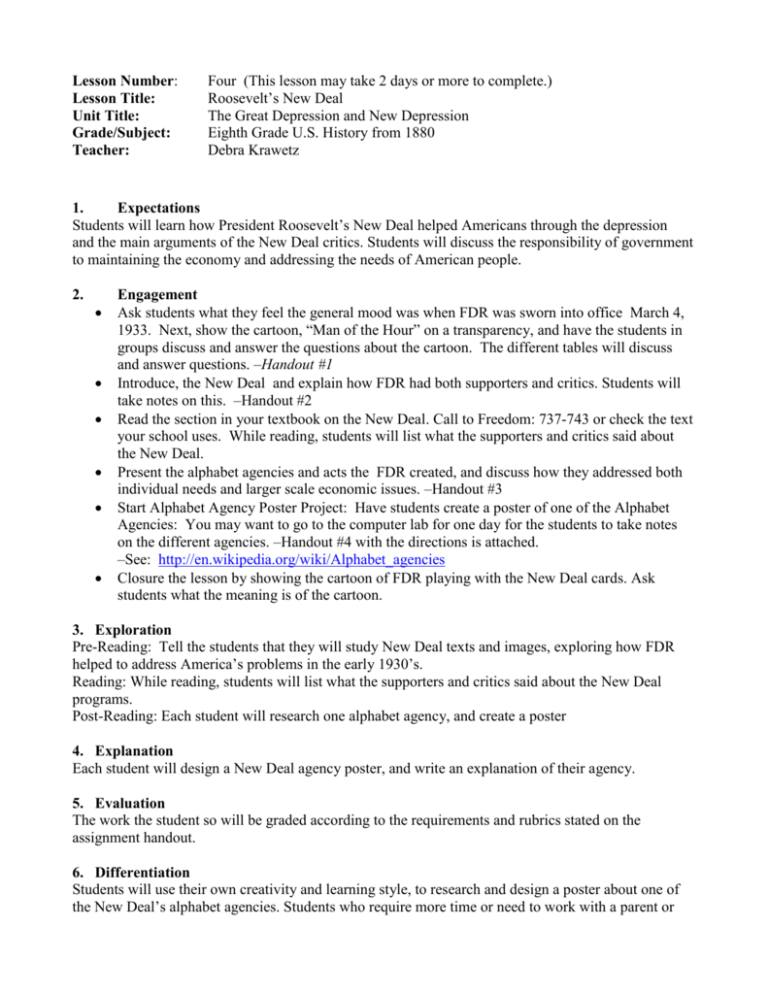
Lesson Number: Lesson Title: Unit Title: Grade/Subject: Teacher: Four (This lesson may take 2 days or more to complete.) Roosevelt’s New Deal The Great Depression and New Depression Eighth Grade U.S. History from 1880 Debra Krawetz 1. Expectations Students will learn how President Roosevelt’s New Deal helped Americans through the depression and the main arguments of the New Deal critics. Students will discuss the responsibility of government to maintaining the economy and addressing the needs of American people. 2. Engagement Ask students what they feel the general mood was when FDR was sworn into office March 4, 1933. Next, show the cartoon, “Man of the Hour” on a transparency, and have the students in groups discuss and answer the questions about the cartoon. The different tables will discuss and answer questions. –Handout #1 Introduce, the New Deal and explain how FDR had both supporters and critics. Students will take notes on this. –Handout #2 Read the section in your textbook on the New Deal. Call to Freedom: 737-743 or check the text your school uses. While reading, students will list what the supporters and critics said about the New Deal. Present the alphabet agencies and acts the FDR created, and discuss how they addressed both individual needs and larger scale economic issues. –Handout #3 Start Alphabet Agency Poster Project: Have students create a poster of one of the Alphabet Agencies: You may want to go to the computer lab for one day for the students to take notes on the different agencies. –Handout #4 with the directions is attached. –See: http://en.wikipedia.org/wiki/Alphabet_agencies Closure the lesson by showing the cartoon of FDR playing with the New Deal cards. Ask students what the meaning is of the cartoon. 3. Exploration Pre-Reading: Tell the students that they will study New Deal texts and images, exploring how FDR helped to address America’s problems in the early 1930’s. Reading: While reading, students will list what the supporters and critics said about the New Deal programs. Post-Reading: Each student will research one alphabet agency, and create a poster 4. Explanation Each student will design a New Deal agency poster, and write an explanation of their agency. 5. Evaluation The work the student so will be graded according to the requirements and rubrics stated on the assignment handout. 6. Differentiation Students will use their own creativity and learning style, to research and design a poster about one of the New Deal’s alphabet agencies. Students who require more time or need to work with a parent or resource teacher will be given that opportunity. The writing component of the activity will be adjusted for students who have difficulty writing. 7. Handouts and Resources -See handouts in this packet New Deal Websites: http://www.authentichistory.com/1930s.html#images http://memory.loc.gov/ammem/wpaposters/wpahome.html http://en.wikipedia.org/wiki/Alphabet_agencies http://newdeal.feri.org/library/index.htm http://www.bergen.org/AAST/projects/depression/successes.html http://www.nps.gov/fdrm/home.htm Lesson Four: Handout #1 “ The Man of the Hour ” Fred O. Seibel Richmond Times Dispatch, 1933 1. How is FDR portrayed? 2. What challenges does FDR face as he embarks on his new job as president? 3. What objects are included in the cartoon, and what do they symbolize? 4. What does, “man of the hour” mean? Lesson Four: Handout #2 The New Deal: “I pledge you, I pledge myself, to a new deal for the American people.” –Acceptance speech at democratic Convention, 1932 The New Deal is the name given to the programs launched by President Franklin D. Roosevelt during 1933-1937, with the goal of RELIEF, RECOVERY, and REFORM to the national economy. During FDR’s first “100 Days” in office, he created many “alphabet agencies,” some set up by Congress, others by executive order, to help Americans during this difficult period. FDR told the American people at his inaugural: “This nation asks for action, & action now.” Supporters Said … Brought economic recovery Prevented the economic and political collapse of the U.S. Created government jobs for unemployed Created programs to prevent future depressions Gave relief to the farmers Created jobs for young American Instilled more hope in the future Supported the work of artists Set a precedent for the federal government playing a key role in the economic and social policies of the nation Critics thought that… The New Deal did not do enough for people Too expensive It was disorganized and the programs were not well thought out. It did not address African Americans’ troubles Tremendous cost would further bankrupt the country The Supreme Court and others felt it gave the president too much power. Some judges felt it was unconstitutional. It expanded the role of the federal government Lesson Four: Handout #3 Vocabulary List #2: The New Deal, Alphabet Agencies and Acts AAA: CCC: CWA EBA Agriculture Adjustment Act Civilians Conservation Corps Civil Works Administration Emergency Banking Act FDIC National Recovery Administration Federal Deposit Insurance Corporation FERA Federal Emergency Relief Administration NRA FLSA FSA: PWA SEC SSA Fair Labor Standard Act Farming Security Administration Public Works Administration Securities and Exchange Commission Social Security Act TVA Tennessee Valley Authority WPA Works Progress Administration Paid farmers to produce crops and taught soil erosion prevention methods A work and relief program that sent young, unemployed men to work on conservation projects in rural areas for $1 per day. Provided public works jobs at $15/week to four million workers in 1934. This act gave the executive branch to right to regulate banks Authorized the president to regulate industry and to raise wages and prices. Insured deposits in bank accounts; the FDIC currently guarantees checking and savings deposits in member banks up to $100,000 per depositor. Provided “relief” to the needy. FERA provided state assistance for the unemployed and their families Established a minimum wage and a 40-hour work week. Brought farmers together to work on large government-owned farms using modern techniques; Provided loans for farmers to buy land Received $3.3 billion appropriation from Congress for public works projects. An agency of the U.S. government that regulates transactions in securities (stocks and bonds) to protect investors against malpractice. Provided pensions, unemployment insurance, and aid to blind, deaf, disabled, and dependent children. Build dams, provided electricity, and bought modern farming methods to the Tennessee River Valley, a poor and region of the U.S. at that time. Employed 8.5 million workers in construction and other jobs; provided work in arts, theater, and literary projects. Lesson Four: Handout #4 Cartoon Parody of New Deal: FDR Playing with Alphabet Cards, 1933 What is the message here about Roosevelt’s New Deal? How is FDR portrayed here? Explain Lesson Four: Handout #5 Project: Alphabet Agency Posters The Great Depression and New Deal Unit Directions: The New Deal introduced government agencies to address the problems that Americans faced. You will investigate one agency and then create a 9” x 24” poster that explains the agency’s role to the American people. Study the actual posters from the 1930’s are available in class to look at before you produce your own. Materials: Books, the Internet, colored pencils, 9” x 24,” drawing paper. Your design will be graded on the following criteria: Grading Rubric and Requirements: Your Poster Will... 1. Show its agency’s work and how the public benefits from the agency to solve the problems of the depression. 2. Advertise and win public support for the agency. 3. Be neatly and creatively completed 4. Include a 3-paragraph explanation about your agency and poster. (Paraphrase information if you take information from websites or books.) *This part will be completed in school but may need to be taken home. Paragraph 1: State the year the agency was founded, its main purpose and, and if it was created by FDR in an “executive order” or enacted by congress. State if this agency is still around today? In not, when did it cease and why? *You will need to research this. Paragraph 2: Explain “who” the workers were, where (the state/region) they worked, and the specific type of work they performed, training they received, and how much they were paid. Include information of how many people worked in this agency if available. *Include a photograph of the workers. Paragraph 3: Describe your poster, the designs and colors you used, and how it represents the agency that you studied. How does your poster depict your agency and its work? If there are words on your poster, explain them. Websites to find more information about the New Deal alphabet agencies: 1. http://www.authentichistory.com/1930s.html#images 2. http://memory.loc.gov/ammem/wpaposters/wpahome.html 3. http://en.wikipedia.org/wiki/Alphabet_agencies 4. http://newdeal.feri.org/library/index.htm http://www.bergen.org/AAST/projects/depression/successes.html New Deal Posters NRA, 1934 Lesson Four: Handout #6 WPA Travel Poster WPA Poster Lesson Four: Handout #7 CCC Poster, 1935 1939 By Albert Bender WPA Poster, Unknown Artist WPA, Federal Art Project WPA Poster National Parks Poster Lesson Four: Handout #8 WPA United Mine Workers of America WPA Federal Music project TVA Logo Lesson Number: Lesson Title: Unit Title: Grade/Subject: Teacher: Five FDR’s Fireside Chats The Great Depression and New Deal Eighth Grade U.S. History from 1880 Debra Krawetz 1. Expectations Students will learn how FDR used his radio addresses, Fireside Chats to calm people’s fears, discuss and explain his new program and enlist public support. Students will read a transcript, or listen to an audio recording of a Fireside Chat. Students will write and perform a Fireside Chat of their own, designed to persuade or sell a New Deal proposal to the American people. Students will submit a transcript for evaluation. Background for Teacher From 1929 and 1931, 4,000 banks closed for good; by 1933 the number rose to more than 9,000, with $2.5 billion in lost deposits. Banks never have as much in their vaults as people deposited. Right after FRD was inaugurated, he declared a national 4-day "bank holiday," closing banks to examine the assets each bank had and actually closed banks that were found financially insolvent. In FRD’S first Fireside Chat, He said, “….it is safer to keep your money in a reopened bank than under the mattress.” 2. Engagement To introduce the topic, first ask students how “today” U.S. Presidents communicates information to the public. List the answers. (24 hour TV news channels like CNN, web news, and point out that the president still has a weekly radio address.) Tell students that in this lesson, we will explore the Fireside Chats that Franklin Roosevelt used to address the nation. Mention that in the 1930’s, the radio became a popular method for communicating both news and entertainment, and by the late 1930’s about 80% of U.S. household owned radios. Display the introduction transparency on Fireside Chats. Read and discuss, and have students take notes. –Handout #1 Distribute a copy of the transcript of the March 12, 1933 Fireside Chat, and Sound Recording Analysis Worksheet for students to fill out while/after they listen. –Handouts # 2 and #3 . Play an audio version of the first Fire Side Chat. Activity: In pair (or individually), students will write and perform a Fireside Chat where they sell a New Deal program to the American people. For evaluation, students will turn in a copy of their transcript and perform their talk for the class. See the assignment sheet and evaluation rubrics for this assignment. –Handout #4 A list of real Fireside chat topics is at: http://www.fdrlibrary.marist.edu/firesi90.html or a list of the Alphabet Agencies is at: http://en.wikipedia.org/wiki/Alphabet_agencies NOTE: Students can research their agency/program in the computer lab, or the teacher can make handouts on all of the different programs for students to use (See Wikipedia for this) 3. Exploration Pre-Listening: Tell the students that they will hear a primary source audio recording of FDR’s first Fireside Chat from March 1933. Provide background schema on Fireside Chats and the banking crisis. Tell students that as they listen, think about ideas for their own Fireside Chat that they will write later in the lesson. Listening--Reading: While listening to the Fireside Chat recording, students will answer questions on a [primary source] recording analysis worksheet about the audio they listened to. Post-Reading: Each student will complete the recording analysis worksheet, and begin the assignment to Write their own Fireside Chat talk to the American people. –See Handout #4 4. Explanation When students write their own versions of FDR’s Fireside Chats, they will explain one of the New Deal programs, describe “who” the program will benefit, and make a persuasive appeal for the support of the American People 5. Evaluation The work the student so will be graded according to the requirements and rubrics stated on the assignment handout. 6. Differentiation Students will use their own creativity and learning style, to research, writer and perform a Fireside Chat. Students who require more time or need to work with a parent or resource teacher will be given that opportunity. The writing or performance aspects of the activity will be adjusted for students who need learning accommodations. 7. Handouts and Resources See handouts in this packet http://www.mhric.org/fdr/fdr.html http://www.fdrlibrary.marist.edu/firesi90.html http://www.americanrhetoric.com/speeches/fdrfirstfiresidechat.html http://en.wikipedia.org/wiki/Fireside_chats Lesson Five: Handout #1 Fireside Chats The fireside chats were a series of 30 evening radio talks given by President Roosevelt between 1933 and 1944, in an attempt to gain support for his New Deal. The Fireside Chats, broadcasted from the White House, gave people a sense of hope and security during difficult times, and helped keep Roosevelt popular despite the continuing depression. FDR’s first Fireside Chat was on March 12, 1933, and the theme was on the banking crisis He explained the measures taken to solve it, and made clear to the country the various facts that might otherwise have been confusing. His talk did much to restore confidence in the government. On May 7, 1933 Fireside Chat broadcast, FDR outlined his plans for the New Deal. Lesson Five: Handout #2 Fireside Chat March 12 1933, Ten O’clock p.m., EST Live from the White House Topic: The Banking Crisis Audio available at: http://history.acusd.edu/gen/20th/fc/01.html or http://www.museum.tv/exhibitionssection.php?page=79 M y Friends, I want to talk for a few minutes with the people of the United States about banking -- with the comparatively few who understand the mechanics of banking but more particularly with the overwhelming majority who use banks for the making of deposits and the drawing of checks. I want to tell you what has been done in the last few days, why it was done, and what the next steps are going to be. I recognize that the many proclamations from State Capitols and from Washington, the legislation, the Treasury regulations, etc., couched for the most part in banking and legal terms should be explained for the benefit of the average citizen. I owe this in particular because of the fortitude and good temper with which everybody has accepted the inconvenience and hardships of the banking holiday. I know that when you understand what we in Washington have been about I shall continue to have your cooperation as fully as I have had your sympathy and help during the past week. First of all let me state the simple fact that when you deposit money in a bank the bank does not put the money into a safe deposit vault. It invests your money in many different forms of credit-bonds, commercial paper, mortgages and many other kinds of loans. In other words, the bank puts your money to work to keep the wheels of industry and of agriculture turning around. A comparatively small part of the money you put into the bank is kept in currency -- an amount which in normal times is wholly sufficient to cover the cash needs of the average citizen. In other words the total amount of all the currency in the country is only a small fraction of the total deposits in all of the banks. What, then, happened during the last few days of February and the first few days of March? Because of undermined confidence on the part of the public, there was a general rush by a large portion of our population to turn bank deposits into currency or gold. -- A rush so great that the soundest banks could not get enough currency to meet the demand. The reason for this was that on the spur of the moment it was, of course, impossible to sell perfectly sound assets of a bank and convert them into cash except at panic prices far below their real value. By the afternoon of March 3 scarcely a bank in the country was open to do business. Proclamations temporarily closing them in whose or in part had been issued by the Governors in almost all the states. It was then that I issued the proclamation providing for the nation-wide bank holiday, and this was the first step in the Government's reconstruction of our financial and economic fabric. The second step was the legislation promptly and patriotically passed by the Congress confirming my proclamation and broadening my powers so that it became possible in view of the requirement of time to extend (sic) the holiday and lift the ban of that holiday gradually. This law also gave authority to develop a program of rehabilitation of our banking facilities. I want to tell our citizens in every part of the Nation that the national Congress -- Republicans and Democrats alike -- showed by this action a devotion to public welfare and a realization of the emergency and the necessity for speed that it is difficult to match in our history. The third stage has been the series of regulations permitting the banks to continue their functions to take care of the distribution of food and household necessities and the payment of payrolls. This bank holiday while resulting in many cases in great inconvenience is affording us the opportunity to supply the currency necessary to meet the situation. No sound bank is a dollar worse off than it was when it closed its doors last Monday. Neither is any bank which may turn out not to be in a position for immediate opening. The new law allows the twelve Federal Reserve banks to issue additional currency on good assets and thus the banks which reopen will be able to meet every legitimate call. The new currency is being sent out by the Bureau of Engraving and Printing in large volume to every part of the country. It is sound currency because it is backed by actual, good assets. As a result we start tomorrow, Monday, with the opening of banks in the twelve Federal Reserve bank cities -- those banks which on first examination by the Treasury have already been found to be all right. This will be followed on Tuesday by the resumption of all their functions by banks already found to be sound in cities where there are recognized clearing houses. That means about 250 cities of the United States. On Wednesday and succeeding days banks in smaller places all through the country will resume business, subject, of course, to the Government's physical ability to complete its survey. It is necessary that the reopening of banks be extended over a period in order to permit the banks to make applications for necessary loans, to obtain currency needed to meet their requirements and to enable the Government to make common sense checkups. Let me make it clear to you that if your bank does not open the first day you are by no means justified in believing that it will not open. A bank that opens on one of the subsequent days is in exactly the same status as the bank that opens tomorrow. I know that many people are worrying about State banks not members of the Federal Reserve System. These banks can and will receive assistance from members banks and from the Reconstruction Finance Corporation. These state banks are following the same course as the national banks except that they get their licenses to resume business from the state authorities, and these authorities have been asked by the Secretary of the Treasury to permit their good banks to open up on the same schedule as the national banks. I am confident that the state banking departments will be as careful as the National Government in the policy relating to the opening of banks and will follow the same broad policy. It is possible that when the banks resume a very few people who have not recovered from their fear may again begin withdrawals. Let me make it clear that the banks will take care of all needs -- and it is my belief that hoarding during the past week has become an exceedingly unfashionable pastime. It needs no prophet to tell you that when the people find that they can get their money -- that they can get it when they want it for all legitimate purposes -- the phantom of fear will soon be laid. People will again be glad to have their money where it will be safely taken care of and where they can use it conveniently at any time. I can assure you that it is safer to keep your money in a reopened bank than under the mattress. The success of our whole great national program depends, of course, upon the cooperation of the public -- on its intelligent support and use of a reliable system. Remember that the essential accomplishment of the new legislation is that it makes it possible for banks more readily to convert their assets into cash than was the case before. More liberal provision has been made for banks to borrow on these assets at the Reserve Banks and more liberal provision has also been made for issuing currency on the security of those good assets. This currency is not fiat currency. It is issued only on adequate security -- and every good bank has an abundance of such security. One more point before I close. There will be, of course, some banks unable to reopen without being reorganized. The new law allows the Government to assist in making these reorganizations quickly and effectively and even allows the Government to subscribe to at least a part of new capital which may be required. I hope you can see from this elemental recital of what your government is doing that there is nothing complex, or radical in the process. We had a bad banking situation. Some of our bankers had shown themselves either incompetent or dishonest in their handling of the people's funds. They had used the money entrusted to them in speculations and unwise loans. This was of course not true in the vast majority of our banks but it was true in enough of them to shock the people for a time into a sense of insecurity and to put them into a frame of mind where they did not differentiate, but seemed to assume that the acts of a comparative few had tainted them all. It was the Government's job to straighten out this situation and do it as quickly as possible -- and the job is being performed . I do not promise you that every bank will be reopened or that individual losses will not be suffered, but there will be no losses that possibly could be avoided; and there would have been more and greater losses had we continued to drift. I can even promise you salvation for some at least of the sorely pressed banks. We shall be engaged not merely in reopening sound banks but in the creation of sound banks through reorganization. It has been wonderful to me to catch the note of confidence from all over the country. I can never be sufficiently grateful to the people for the loyal support they have given me in their acceptance of the judgment that has dictated our course, even though all of our processes may not have seemed clear to them. After all there is an element in the readjustment of our financial system more important than currency, more important than gold, and that is the confidence of the people. Confidence and courage are the essentials of success in carrying out our plan. You people must have faith; you must not be stampeded by rumors or guesses. Let us unite in banishing fear. We have provided the machinery to restore our financial system; it is up to you to support and make it work. It is your problem no less than it is mine. Together we cannot fail. The End Lesson Five: Handout #3 Name Period Sound Recording Analysis Worksheet 1. Pre-Listening A. Whose voices will you hear on this recording? B. What is the date of the recording? C. Where was this recording made? D. Why is the purpose of this recording? 2. Listening A. Type of sound recording. (Speech, Interview…) B. Unique physical qualities of the recording. Write an “x__Music __Live broadcast __Narrated __One voice __More than one voice __Special sound effects __Background sound Other qualities?______________________ Y or N: Pre Television Era C. What is the tone or mood of the country at this time? D. How does the speaker add or change this mood? 3. Post-Listening A. List three things in this sound recording that you think are important: 1. 2. 3. A. Why do you think the original broadcast was made? For what audience was it made? C. Remark on the quality of the speaker’s voice and articulation. D. What do you know about the time-period and this person? E. List 3 things this sound recording tells you about life in the United States at this time F. Write a question to the broadcaster that is left unanswered by this sound recording. G. What information do you gain about this recording that would not be conveyed by a written transcript? –Provide specific examples Lesson Five: Handout #4 FDR Memorial in DC Fireside Chat Activity Assignment: In a group of two or working alone, you will write a 2-page Fireside Chat, and perform it to the class. Your job is to explain the new program and sell the idea, gaining support from the American public. Bring simple props to school when you perform your chat. Web Help: For the real Fireside Chat transcripts see: http://www.fdrlibrary.marist.edu/firesi90.html To learn about the different agencies see: http://en.wikipedia.org/wiki/Alphabet_agencies Topics to choose from: Banking Relief, Farms Programs, Regulating Wall Street, Labor Issues, Unemployment, Social Security, Relief proposals, Programs for the Young (CCC), the Dust Bowl and Drought. –See p. 742 in Call to Freedom for a list of New Deal programs. Requirements/Rubric: Fireside Chat -50 Points 1. 2. 3. 4. 5. A full explanation of the program. –10 points A description of “who” the program will benefit. –10 points An appeal for the support of the American People. –10 points Be persuasive in both your writing and speaking. –10 points Speak clearly and convincingly. –10 points Length: 2-Pages
